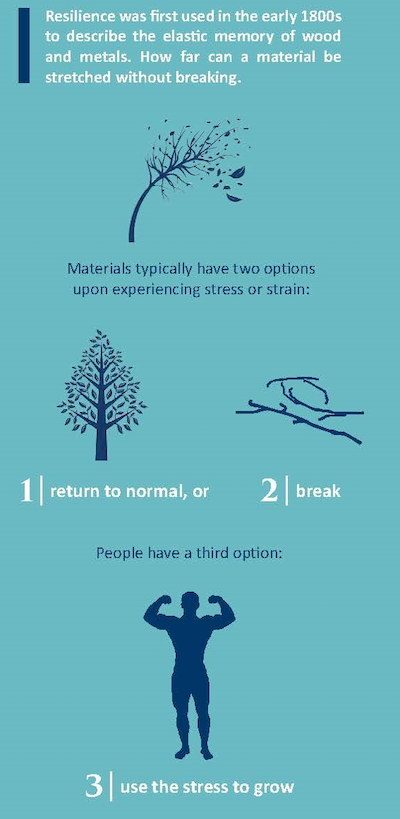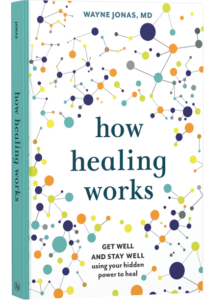A pandemic is never a great time for an English lesson but when it comes to defining the strength and resolve so many in our country, and our planet, have displayed over the recent weeks, it seems appropriate to talk about “resilience.” And, more importantly, what it really means in our shared moment of turmoil.
Traditional definitions of resilience include a major misconception, that resilience is a bouncing back or a return to an original state after a stressor or traumatic event.
When examining resilience as a response to adversity, our current understanding needs to expand beyond the concept of “bouncing back,” to instead, a new normal that is characterized by stability through change. Being resilient entails more than the ability to adjust and adapt but also to transform when the internal and external stresses require a new way to effectively proceed forward.
Staying the same is impossible after experiencing the stress of a pandemic or war, the loss of a limb, or enduring a major illness. Although impossible to regain a pre-trauma state, people can be transformed by their experiences, and go on to experience positive, life-affirming lives.
A History of the term
Resilience was first used in the early 1800s to describe the elastic memory of wood and metals. How far can a material be stretched without breaking.
Materials typically have two options upon experiencing stress or strain:
1) return to normal, or 2) break. People have a third option: 3) use the stress to grow.

Growth Through Stress
Merely experiencing stress does not cause growth. Growth comes from the struggle to cope with the disruptions—not from the event itself.
Avoiding trauma can be impossible. People experience bereavement, life-threatening or life-changing illness, serious medical problems of their children, transportation accidents, house fires, combat, sexual assault and abuse.
Psychologists Richard G. Tedeschi and Lawrence Calhoun describe five areas of growth reported by people who have experienced these and other traumatic events:
- Discovery of new opportunities and possibilities that were not present before
- Closer relationships with others, especially others who suffer
- Greater appreciation for life
- Greater sense of personal strength: “If I lived through that, I can face anything”
- Spiritual growth
The Way Forward: Healthy Communities
Community resources are precious and when people, families, businesses, and organizations use resilience thinking the community and its members can better adapt to stresses and major trauma whether they are anticipated or not.
Working alone and collaboratively people, families and community leaders can set priorities and agendas to make beneficial changes build wellness, wellbeing and prosperity in good times, and prepare for, respond to, and recover from bad times. Healthy resilient communities might:
- Align existing personal, family and community resilience, fitness, and wellbeing related goals across organizational boundaries;
- Seek convergences of purpose, and in common, recognize existing assets;
- Share key principles about personal and community resilience, anchored by positive behaviors, attitudes and habits;
- Establish practical and locally meaningful resilience, wellbeing, and readiness measures/metrics; and
- Encourage community members and leaders to discover what works and do more of it.
Community resources are precious and when people, families, businesses, and organizations use resilience thinking the community and its members can better adapt to stresses and major trauma whether they are anticipated or not.
Working alone and collaboratively people, families and community leaders can set priorities and agendas to make beneficial changes build wellness, wellbeing and prosperity in good times, and prepare for, respond to, and recover from bad times. Healthy resilient communities might:
- Align existing personal, family and community resilience, fitness, and wellbeing related goals across organizational boundaries;
- Seek convergences of purpose, and in common, recognize existing assets;
- Share key principles about personal and community resilience, anchored by positive behaviors, attitudes and habits;
- Establish practical and locally meaningful resilience, wellbeing, and readiness measures/metrics; and
- Encourage community members and leaders to discover what works and do more of it.
DON’T JUST SURVIVE—PREPARE, ADAPT, and THRIVE!
For those in the midst of a crisis, like the health care workers on the front lines of the most recent pandemic, being resilient means taking care of oneself in addition to one’s patients. But these tips apply to everyone.
Take care of your BODY
Eat well, sleep, stay hydrated, use nutritional substances appropriately, and take bathroom breaks.
Take care of your MIND
Learn to manage stress. Exercise good decision-making. Even just 5-10 minutes of decompression time is critical during a crisis. Recognize the good. Look for helpers.
Take care of your SPIRIT
Find meaning outside of yourself. This can be by volunteering or establishing relationships with a spiritual or faith-based community.
Stay CONNECTED
Connect with family and colleagues via phone, letters, video or virtually. Those who thrive have strong relationships. Ask for help if you need it.
This period will certainly change much in our lifetimes and alter the lives of the generations to come but that doesn’t necessarily mean that change has to be negative. We grow and adapt as a species when required and we learn from those experiences and become better for it. That is what defines us.
Where to Find Trusted Information and Resources
During this crisis, please be wary of how and where you consume your information. We don’t recommend inundating yourself with news and media coverage as it can greatly impact your stress levels and, as a result, your immune system and overall wellbeing. Therefore, when you do seek out news coverage or need useful material to help you in times of need, use the following resources:
- The Centers for Disease Control and Preventions: the website has excellent information on maintaining mental and emotional health including resources and phone numbers, as well as offers helpful guidelines on staying safe and preventing the spread of COVID-19.
- The World Health Organization: a great site that includes trustworthy media coverage and research along with travel guidelines and a helpful “myth busters” section that is worth sharing.

Take Your Health Into Your Own Hands
Drawing on 40 years of research and patient care, Dr. Wayne Jonas explains how 80 percent of healing occurs organically and how to activate the healing process.

